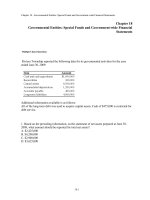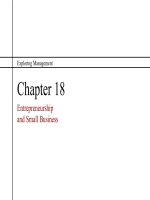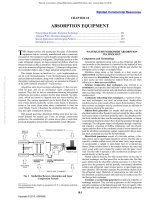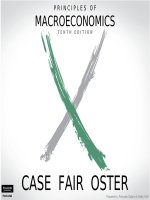Kendall7E ch18
Bạn đang xem bản rút gọn của tài liệu. Xem và tải ngay bản đầy đủ của tài liệu tại đây (2.79 MB, 75 trang )
Object-Oriented
Systems
Analysis and Design
Using UML
Systems Analysis and Design,
7e
Kendall & Kendall
© 2008 Pearson Prentice Hall
18
Learning Objectives
• Understand what object-oriented systems analysis
•
•
•
•
and design is and appreciate its usefulness
Comprehend the concepts of unified modeling
language (UML), the standard approach for
modeling a system in the object-oriented world
Apply the steps used in UML to break down the
system into a use case model and then a class
model
Diagram systems with the UML toolset so they can
be described and properly designed
Document and communicate the newly modeled
object-oriented system to users and other analysts
Kendall & Kendall
18-2
Object-Oriented Analysis and
Design
• Works well in situations where
complicated systems are undergoing
continuous maintenance,
adaptation, and design
• Objects, classes and reusable
• The Unified Modeling Language
(UML) is an industry standard for
modeling object-oriented systems
Kendall & Kendall
18-3
Object-Oriented Analysis and
Design (Continued)
• Reusability
• Recycling of program parts should
reduce the costs of development in
computer-based systems
• Maintaining systems
• Making a change in one object has a
minimal impact on other objects
Kendall & Kendall
18-4
Major Topics
• Object-oriented concepts
• CRC Cards and object think
• Unified Modeling Language
• Use case and other UML diagrams
• Packages
• Using UML
Kendall & Kendall
18-5
Object-Oriented Concepts
• Objects
• Classes
• Inheritance
Kendall & Kendall
18-6
Objects
• Persons, places, or things that are
relevant to the system being
analyzed
• May be customers, items, orders
and so on
• May be GUI displays or text areas
on a display
Kendall & Kendall
18-7
Classes
• Defines the set of shared attributes and
behaviors found in each object in the class
• Should have a name that differentiates it
from all other classes
• Instantiate is when an object is created
from a class
• An attributes describes some property
that is possessed by all objects of the
class
• A method is an action that can be
requested from any object of the class
Kendall & Kendall
18-8
Figure 18.1 An example of a UML class. A class
is depicted as a rectangle consisting of the class
name, attributes, and methods
Kendall & Kendall
18-9
Inheritance
• When a derived class inherits all
the attributes and behaviors of the
base class
• Reduces programming labor by
using common objects easily
• A feature only found in objectoriented systems
Kendall & Kendall
18-10
Figure 18.2 A class diagram showing
inheritance. Car and truck are specific examples
of vehicles and inherit the characteristics of the
more general class vehicle
Kendall & Kendall
18-11
CRC Cards and Object
Think
• CRC
• Class
• Responsibilities
• Collaborators
• CRC cards are used to represent
the responsibilities of classes and
the interaction between the classes
Kendall & Kendall
18-12
Figure 18.3 Four CRC cards for course offerings show how
analysts fill in the details for classes, responsibilities, and
collaborators, as well as for object think statements and
property names
Kendall & Kendall
18-13
Interacting during a CRC
Session
• Identify all the classes you can
• Creating scenarios
• Identify and refine responsibilities
Kendall & Kendall
18-14
The Unified Modeling
Language (UML) Concepts
and Diagrams
• Things
• Relationships
• Diagrams
Kendall & Kendall
18-15
Things
• Structural things are
• Classes, interfaces, use cases, and other elements
•
•
•
•
that provide a way to create models
They allow the user to describe relationships
•
Behavioral things
Describe how things work
• Interactions and state machines
Group things
• Used to define boundaries
Annotational things
• Can add notes to the diagrams
Kendall & Kendall
18-16
Relationships
• Structural relationships
• Tie things together in structural
diagrams
• Behavioral relationship
• Used in behavioral diagrams
Kendall & Kendall
18-17
Structural Relationships
• Dependencies
• Aggregations
• Associations
• Generalizations
Kendall & Kendall
18-18
Behavioral Relationships
• Communicates
• Includes
• Extends
• Generalizes
Kendall & Kendall
18-19
Diagrams
• Structural diagrams
• Used to describe the relation between
classes
• Behavior diagrams
• Used to describe the interaction
between people (actors) and a use
case (how the actors use the system)
Kendall & Kendall
18-20









